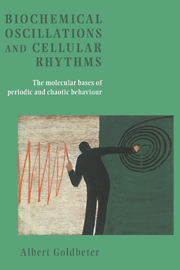Book contents
- Frontmatter
- Contents
- Foreword to the English edition by Michael Berridge
- Foreword to the French edition by Ilya Prigogin
- Preface
- 1 Introduction
- Part I Glycolytic oscillations
- Part II From simple to complex oscillatory behaviour
- Part III Oscillations of cAMP in Dictyostelium cells
- Part IV From cAMP signalling in Dictyostelium to pulsatile hormone secretion
- Part V Calcium oscillations
- 9 Oscillations and waves of intracellular calcium
- Part VI The mitotic oscillator
- Part VII Circadian rhythms
- References
- Index
9 - Oscillations and waves of intracellular calcium
Published online by Cambridge University Press: 26 February 2010
- Frontmatter
- Contents
- Foreword to the English edition by Michael Berridge
- Foreword to the French edition by Ilya Prigogin
- Preface
- 1 Introduction
- Part I Glycolytic oscillations
- Part II From simple to complex oscillatory behaviour
- Part III Oscillations of cAMP in Dictyostelium cells
- Part IV From cAMP signalling in Dictyostelium to pulsatile hormone secretion
- Part V Calcium oscillations
- 9 Oscillations and waves of intracellular calcium
- Part VI The mitotic oscillator
- Part VII Circadian rhythms
- References
- Index
Summary
Experimental observations on cytosolic Ca2+ oscillations
Ca2+ oscillations are among the most significant findings of the last decade in the field of intracellular signalling. Together with the mitotic oscillator, which underlies the eukaryotic cell division cycle (examined in chapter 10), Ca2+ oscillations are also one of the most important periodic phenomena uncovered in recent years in the field of biochemical and cellular oscillators. Ca2+ oscillations are of interest for a variety of reasons. First, they occur in a large number of cell types, either spontaneously or after stimulation by hormones or neurotransmitters. Second, it is by now clear that they represent the oscillatory phenomenon that is the most widespread at the cellular level, besides the rhythms encountered in electrically excitable cells. Third, Ca2+ oscillations are often associated with the propagation of Ca2+ waves within the cytosol, and sometimes between adjacent cells; even though its physiological significance remains to be determined, this phenomenon has become one of the most important examples of spatiotemporal organization at the cellular level.
Since their first direct observation in fertilized mouse oocytes (Cuthbertson & Cobbold, 1985) and hormone-stimulated hepatocytes (Woods et al., 1986,1987), which followed their earlier, theoretical prediction (Rapp & Berridge, 1977; Kuba & Takeshita, 1981) and indirect characterization (Rapp & Berridge, 1981), the number of experimental reports on Ca2+ oscillations has mushroomed at an increasing pace in recent years; these experimental results have been examined in several reviews (Berridge & Galione, 1988; Berridge, Cobbold & Cuthbertson, 1988; Berridge, 1989, 1990; Cuthbertson, 1989; Rink & Jacob, 1989; Cobbold & Cuthbertson, 1990; Jacob, 1990a; Petersen & Wakui, 1990; Tsien & Tsien, 1990; Meyer & Stryer, 1991; Tsunoda, 1991; Fewtrell, 1993) and in a special issue of Cell Calcium (Cuthbertson & Cobbold, 1991).
- Type
- Chapter
- Information
- Biochemical Oscillations and Cellular RhythmsThe Molecular Bases of Periodic and Chaotic Behaviour, pp. 351 - 406Publisher: Cambridge University PressPrint publication year: 1996
- 1
- Cited by



